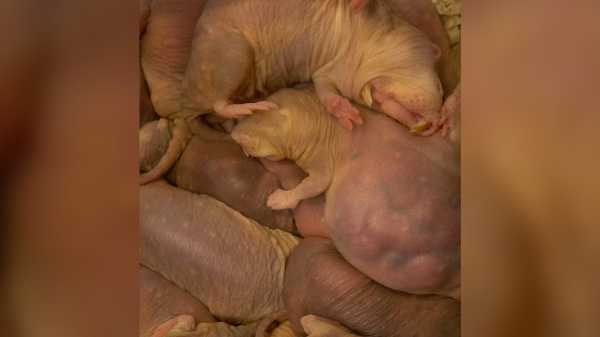
Naked mole rats are supremely weird creatures — they don’t need much oxygen, and instead have seizures if they don’t get enough carbon dioxide, the chemical humans exhale when we breathe, researchers just found.The scientists found that the wrinkled rodents will even seek out areas that have been infused with the gas.
But why? Turns out, due to a genetic mutation, naked mole rats lack an important switch in their brains that helps to tamp down electrical activity in the organ, and thus, prevent seizures, according to a new study published today (April 30) in the journal Current Biology. This mutation might seem dangerous, but in reality, it allows the mole rat to conserve its precious energy stores. Rather than expending energy to operate the anti-seizure switch, the rodents rely on carbon dioxide to keep their brain activity in check.
“Carbon dioxide is really good at calming the brain down, if not shutting the brain down,” said study author Dan McCloskey, an associate professor of psychology at the Graduate Center of The City University of New York. McCloskey studies epilepsy, a neurological condition characterized by recurrent seizures, and thinks the study of naked mole rats could help to unravel mysteries surrounding the human medical condition.
For instance, about 2% to 4% of children under age 5 experience seizures after running a high fever — a phenomenon known as a febrile seizure, according to the medical reference site UpToDate. A 2014 study published in the journal EMBO Reports suggests that some of these children share the same genetic quirk that leaves naked mole rats prone to seizures in the absence of carbon dioxide.
While more research will be needed to explain this connection, McCloskey said that his mole rat study hints that, in addition to genetics, air quality and breathing patterns may play important roles in human epilepsy.
“There are probably people walking the planet … who are more sensitive to the air around them,” McCloskey told Live Science. Further research into what provokes seizures in naked mole rats, and what prevents them, could help guide future studies in human patients, he added.

African naked mole rats are crammed together in a colony nest. An unexpected connection
So how did McCloskey, a psychology professor, connect the dots between naked mole rats and children with epilepsy?
“It all started with a fact-a-day calendar I got from my sister-in-law,” he said.
On April 17, 2007, the calendar read, “Did you know: The African naked mole at is neither a mole nor a rat, and is the only cold-blooded mammal,” meaning the animal cannot regulate its body temperature physiologically, but varies in temperature depending on its surroundings. Intrigued by the notion, McCloskey wondered if there might be similarities between naked mole rats and human babies and infants, who cannot effectively regulate their body temperatures as adults can. He began studying the quirky creatures shortly after.
Whereas humans soon outgrow their poor thermoregulation ability, naked mole rats of all ages must move about their nests to maintain an optimum body temperature, retreating deeper underground during the hottest hours of the day and huddling for warmth when necessary, McCloskey and his co-authors noted.
In addition to seeking out that thermal sweetspot, the rodents spend more than 70% of their time in a so-called nest chamber, where the queen naked mole rat and a breeding male spend most of their time, the authors found. The chamber contains the highest concentration of carbon dioxide in the nest, reaching 2.33% of the total atmospheric pressure, as compared with about 0.5% in nearby food chambers and as little as 0.05% in toilet chambers. The team housed two naked mole rat colonies in their lab and were able to infuse carbon dioxide into different chambers of the nest to see what would happen. The mole rats responded by visiting those areas more frequently and even relocating their primary nest chamber near the infusion site.
The behavior suggested that naked mole rats not only tolerate high concentrations of carbon dioxide, they actually seek them out. Further research revealed one reason why: the compound might protect the mole rats from seizures.
Carbon dioxide as an anticonvulsant
When exposed to hot air, heated to about 107 degrees Fahrenheit (42 degrees Celsius), with a low concentration of carbon dioxide, naked mole rats begin to hyperventilate and seize just as infants do during a febrile seizure, the authors found. Many mammals hyperventilate when extremely overheated, as the reflex releases moderate amounts of heat from the body, McCloskey said. Hyperventilating also rids the body of carbon dioxide, which may not be the best thing for naked mole rats.
While the mole rats suffered seizures in the low-CO2 air, they did not seize when the team used hot air with similar carbon dioxide concentrations (around 2.5%) as those found in the nest chamber. The high-CO2 air even helped suppress seizures in mole rats that had been deprived of carbon dioxide for certain periods of time, as evidenced by measurements of the animals’ brain waves. However, some signs of seizure, such as head bobbing and twitchy mouth movements, persisted throughout the experiment. After experiencing a seizure in the low-CO2 air, the mole rats’ blood was also less acidic due to the marked loss of carbon dioxide.
Taken together, these findings suggested that carbon dioxide deprivation, not heat, somehow triggered the rodents’ seizures. When the levels of carbon dioxide get low, their blood gets too basic, meaning less acidic, “and that’s what causes the seizures,” said Thomas Park, a professor and associate department head of Biological Sciences at the University of Illinois at Chicago, who was not involved in the study.
The big question is why.
To find out, McCloskey teamed up with researchers from the University of Helsinki in Finland, who conducted the 2014 EMBO Reports study. By studying a family with a history of febrile seizures, the Helsinki researchers had spotted a rare mutation in a gene that normally helps regulate brain activity. Upon joining the naked mole rat project, they wondered if the rodents might harbor a similar mutation. Turns out, they share the exact same gene variant.
When mutated, this gene prompts brain cells to build a faulty version of KCC2, a protein that normally pumps chloride out of cells in response to certain signals.
Charged particles such as chloride, which carries a negative charge, move in and out of brain cells in response to various chemicals, known as neurotransmitters. When the balance of negative and positive charges within the cell hits a certain threshold, the brain cell fires off an electrical pulse and sends the signal on to nearby cells. In the adult brain, a neurotransmitter called GABA controls the flow of chloride in and out of neurons and normally works to suppress electrical activity — dampen the ability of brain cells to fire. But in young mammals like human babies, and juvenile rats and mice, things may work a bit differently.
Baby brains
Early in development, brain cells contain a far higher concentration of chloride than they do in the adult brain, according to a 2019 report published in the journal Science. At the same time, these immature brain cells contain very little KCC2, meaning they cannot easily get rid of chloride. That buildup of chloride triggers the neurotransmitter GABA — the chemical that normally suppresses too much neural activity; but in these immature brain cells, GABA might actually promote electrical activity, McCloskey said.
In young kids, the chloride “actually acts more like a gas pedal than a break,” which may be important to some aspects of early brain development, he said. Chloride also acts as a gas pedal in naked mole rats of all ages, he found. Basically, naked mole rats seem to maintain “baby brains” throughout their life spans, he said.
To test this theory, the team investigated how naked mole rats would react to the anti-seizure medication diazepam, which boosts GABA activity in an attempt to calm brain cells. Rather than suppress seizures, though, the drug “rapidly triggered seizures when injected in normal air at room temperature.” But in carbon dioxide-rich air of the same temperature, diazepam kicked in as it does in other adult rodents: It put the mole rats to sleep.
With the help of carbon dioxide, GABA can turn down electrical activity in the mole rat brain, despite their genetic mutation, McCloskey said.
“They’re using the byproduct that we usually consider to be bad and they’re using it for good,” Park added. A typical KCC2 pump costs ample amounts of energy to run, and given their cramped, underground habitat and limited food supply, naked mole rats don’t have much energy to spare. By taking advantage of the carbon dioxide in their nests, rather than constantly using the KCC2 pump, the rodents can save energy while still keeping their brain activity under control, Park said.
While naked mole rats use carbon dioxide to control their seizures all the time, a similar strategy could help epilepsy patients in the short-term. A 2011 study led by the University of Helsinki suggested that doctors could quickly suppress seizures in epilepsy patients by having them inhale air made up of 5% carbon dioxide. Now, physicians in Finland “keep CO2 bottles on hand” for acute epilepsy treatment, and specifically for infants with febrile seizures, McCloskey said.
More research is needed to determine precisely how the compound interacts with the GABA system, McCloskey said. And naked mole rats may rely on more than carbon dioxide to keep seizures at bay, he added. “We’re curious about what other strategies these guys are using” and whether any could translate into humans, he said.
Beyond health care, the study fills in a missing chapter in mole rat evolutionary history, suggesting that the animals’ unique social structure may partially stem from the need to control their seizures without expending too much energy. Many other factors drove naked mole rats underground 35 million years ago, and the animals adapted to their new home in increasingly bizarre ways, such as never dying of old age, McCloskey said.
“All of these factors together make you wonder, ‘well, what [adaptations] came first?'” Park said. “It’s a mystery because we can’t go back … and observe what happened.”
Sourse: www.livescience.com





